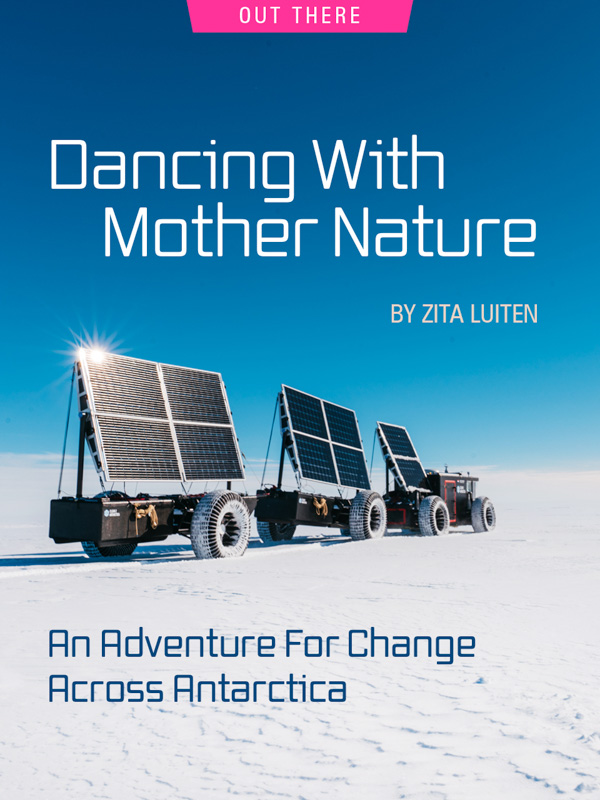Potential in plastic: A team travels to Antarctica in a vehicle made mostly of recycled plastic to pave a new environmental (and life) path for us all.
—
I’ve always believed that a lack of comfort is needed before change happens. It’s like they say, “Life happens outside of your comfort zone.” Well… so does change. I took that to heart and joined Clean2Antarctica on an expedition in Antarctica as part of the media team. We ventured on towards the South Pole for 30 days, without any fossil fuel, in a car made primarily from recycled plastic.
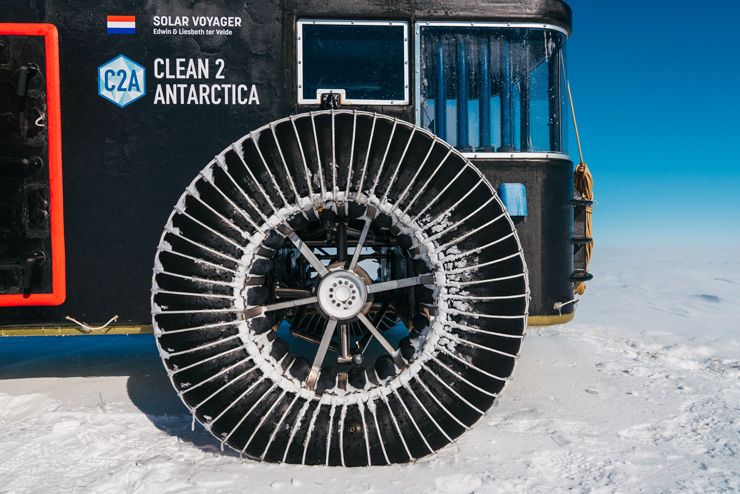
THE BEGINNING
It all started where most times, it ends: with trash. The creators of Clean2Antarctica, Edwin & Liesbeth ter Velde, are a normal, married couple living in Zaandam, The Netherlands. One day, as they threw away yet another piece of plastic in their kitchen, they asked themselves:
“Why does this plastic lose its value after you take out what was in it? There is nothing in its essence that has changed, so why does our way of perceiving it change?”
It is only our minds that make something ‘trash.’
It got them thinking. That plastic that normally ends in the (recycle) bin served its purpose of holding our food, but what other purpose could it serve? Could we use it to do something else? Why did it have to end here?
If plastic could be considered a building material, and not trash, what could be made of it? “Why not a car?” Edwin imagined. He devised ideas for a car made predominantly from recycled plastic, with solar panels that make it completely emission-free. And thus, the idea of the Solar Voyager was born.
If you do something, do it BIG. “No guts, no glory (or no story),” Edwin & Liesbeth kept saying.
Antarctica is the coldest, driest, windiest and highest continent in the world, and therefore one of the most dangerous — the least likely place for success for a car that is made out of plastic, running on solar power. “If we can drive a plastic car fueled by solar power there, we can do it anywhere. If we can do what everyone keeps telling us is impossible, then we can all do something.” The purpose was born. In the process of 3 years, there were many people who told them it wouldn’t be possible, it couldn’t be done. But they persisted. They continued on — and now, it’s done.
We’re recently back from Antarctica… back from an expedition that proved to be challenging on many fronts.
I was part of the media team invited to document the expedition. I followed Edwin & Liesbeth, in a different car, as they drove on. There are many stories to be told about an expedition like this but allow me to share a bit of what I experienced and what I have learned.
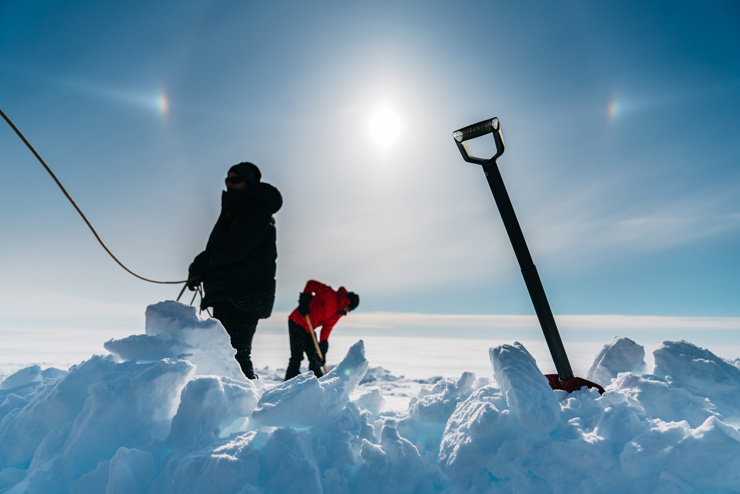
THE JOURNEY
We spent 30 days on the ice, setting out to travel 1200km to and from the geographical South Pole. Antarctica, in summer periods, has 24 hours of daylight and normally, 24 hours of sun. In our 30 days, unfortunately we did not see much of that sun, something that certainly changed the way we perceived the expedition (and not so great for our solar panels). But first, let me explain to you what a day looked like during our adventure.
Every day feels a bit the same. You get up from your tent: it’s cold, and surprise — it’s still light. There’s not much on your mind except for the weather and survival. You’re completely disconnected from the outside world, both physically and mentally.
All of that excess stuff that typically fills your mind, doesn’t really matter. You’re here in the now…
In this world of ice and whiteness — surrounded by nothing, without any life around you, completely dependent on yourself and your senses. It is an odd and exhilarating sensory experience.
There are a few essentials: warmth, water, toilet, food, travel and sleep. That’s your day, and meeting those needs will consume all of it, and all of your energy.
You’ve got to keep warm, wear many layers, and make sure nothing gets wet. On average, it’s about minus 20 degrees Celsius. With added wind it can feel a lot colder. Wearing the right clothes is critical. I always wore at least 3 base layers, one thermal, one normal, and one fleece. Over that, I’d wear something that would protect me from the wind. If needed, I’d also wear a duck-feathered coat on extremely cold days. Gloves and very thick socks were a necessity. You had to keep them dry, because if they got wet, they’d freeze.
Making water is the most important task of the day. This is essential for preparing food, and as your body deals with the cold you need to feed it properly and consume lots of water. The Solar Voyager had heat pipes that would melt the ice and boil it into water, powered by the sun.
We ate out of bags. Just add water and enjoy your meal. While there was diversity in the choices of food, eating out of a bag for 30 days can get boring very quickly. Back home in The Netherlands, I enjoy nutritious cooking and actually think about food throughout the day. But in Antarctica, food is just fuel for your body, which is incredibly important in these conditions.
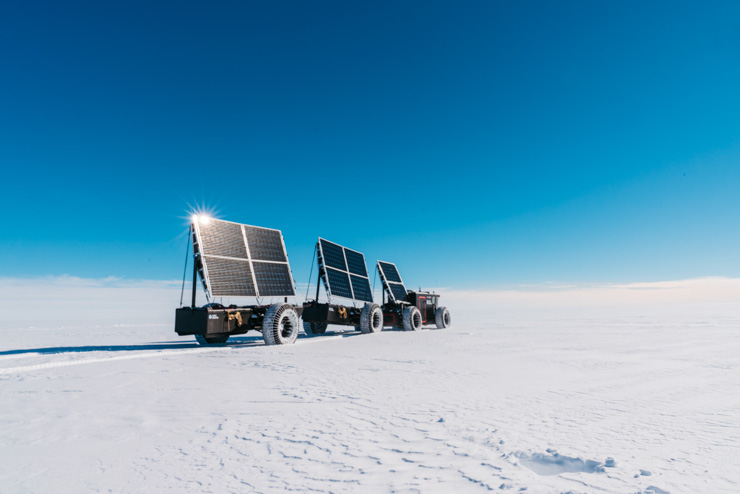
Antarctica is a waste-free continent — which means when going to the toilet, you have to carry out whatever you leave behind. You can’t leave any waste, not even natural feces.
Every day, we tried to travel, but due to weather, we couldn’t always. We got stuck in many storms, where we had to put up our tents in very difficult situations and stay for days on end. The Solar Voyager required sun to charge and be able to drive, so we waited it out.
And even when focusing on the same tasks each day, every day was completely different. Every day, you can’t help but be mesmerized by the awesome beauty of nature.
Every whiteout we experienced was different, as was every sunny day. It’s amazing how small the world can feel during a whiteout, when you feel like you can see nothing further than 2 meters — where every step you take, feels like you will fall into the ground. In reality, you can see a lot further than imagined. It’s only because both earth and sky are white, that your eyes have nothing to focus on — no contrast on the horizon. On a sunny day, you feel like the world doesn’t end. You can see the horizon round, and it feels like you can see for thousands of miles. So, in a single day, your world can go from endless to incredibly small.
An experience like this expands everything. It makes you reshape concepts and thoughts.
Just like Edwin & Liesbeth reshaped their thoughts about ‘trash,’ we all had our own kinds of thought transformations in Antarctica. There are 4 main constructs I reshaped during the expedition: time, turbulence, traces and targets.
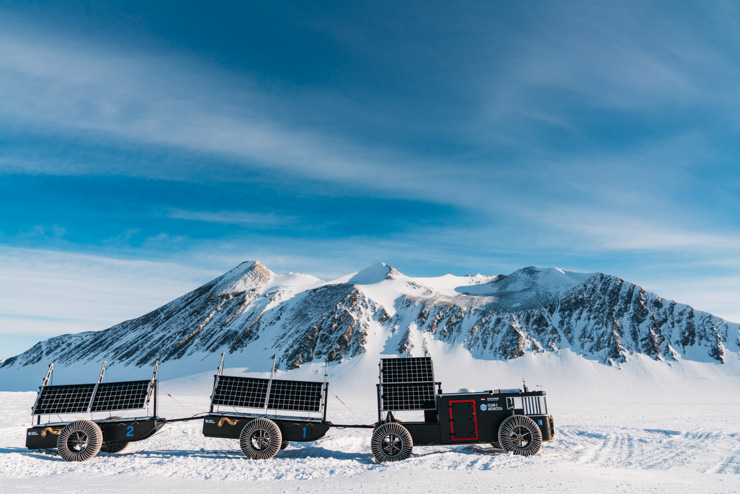
TIME
In a surrounding that’s so white, especially in a whiteout storm like we often experienced, you feel like there’s nothing besides your crew and nature, and everything else becomes obsolete. You come to live smaller, and time becomes less of a thing. You don’t look to the clock to guide you through your day. It’s light all 24 hours, so you eat and sleep when your body tells you to. Special moments are just moments. We spent Christmas Eve eating out of a bag. But it’s only a moment in time, and in such a small world, that doesn’t really matter. Time fades away.
And yet, time also gained importance because time has many meanings. Time is a certain arrangement of the clock, a specific moment in someone’s life, or in history. Time is the future, and time is the past. But time, as a word, can also be used to signify a need.
Time is a reference for a turning point of action. And that’s the kind of time that becomes really important.
Antarctica showed us that nature is stronger than we are, and we’re merely surviving in it. So instead of fighting it, we embraced it. It might not be comfortable initially, but there’s comfort in embracing what’s stronger than we are. It’s time for us to see things differently.
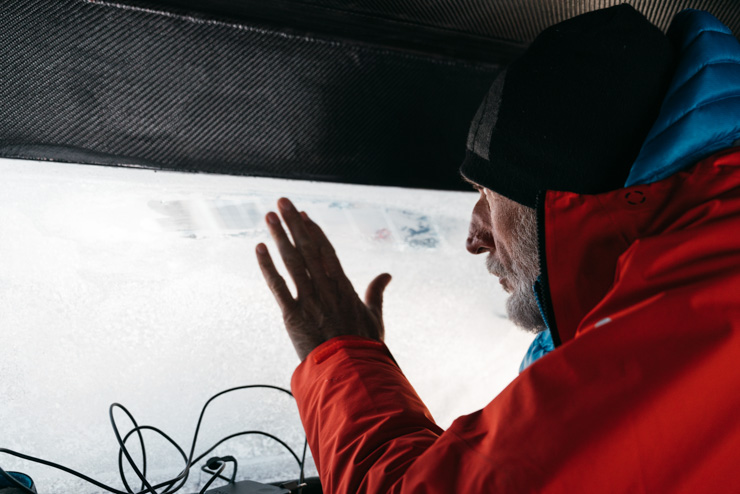
TURBULENCE
We were only about 80 km away from where we started, and already we were stuck. Our plastic car was doing amazingly: all systems worked perfectly, everything inside of our control worked great, but Mother Nature decided against it. We put up our tents while it was still sunny, and then literally one minute later, everything was white. It was snowing, and with a windspeed of about 40 knots, the snow flew horizontally instead of falling straight down.
Walking outside, it felt like a two-faced world, ebony or ivory, heaven or hell, the polarity of mankind vs. nature. Facing against the wind, you could hardly even breathe. But with your back against the wind, there was almost a calming feeling — like a gentle press on your back.
This went on for a day and a half. And then it happened again a day later, slowing us down another couple of days. When we woke up in the morning, we were almost completely snowed in. The wind created these amazing dunes, in line with our tents and the Solar Voyager. Extraordinary shapes came to existence. The sunlight returned and shed a bright and shining light on these new creations.
There are so many things in life that we can control. Especially in the century we are living in — we want to be able to control everything. But this one thing, we just can’t. Nature will reign supreme whether we like it or not. She will storm when she wants to storm, and she will show us sun if she wants to.
Nature will reign supreme whether we like it or not. She will storm when she wants to storm, and she will show us sun if she wants to.
Nature can create turbulence in a situation that felt calm mere moments before. But just like nature, so can we. And even if we don’t always like turbulence, sometimes we need it, if only just a little bit.
Turbulence can set into motion a new state of things. Sometimes, we need a little revolution to stir things up.
We need to raise our voices in order to recreate what we had before. We need to do things that might seem crazy, like driving across Antarctica in a plastic car, to change some minds and inspire others. We need a little bit of turbulence to see the sun again, and to see what was created in the process.
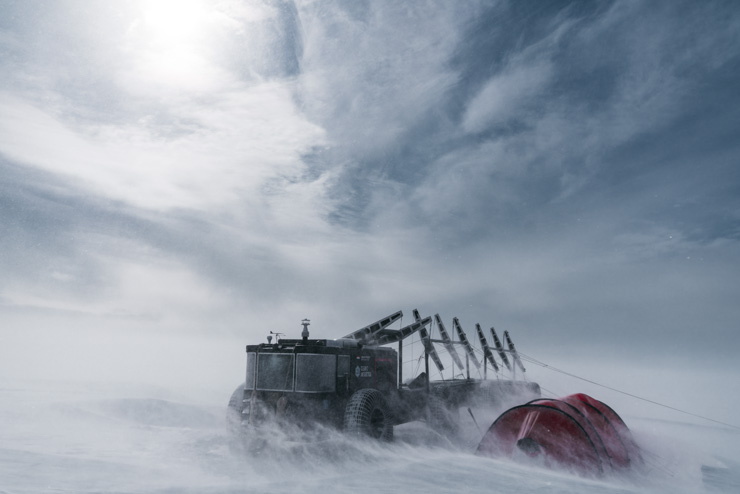
TRACES
After about two weeks, we felt a bit hopeless. We were not on track and had already encountered many storms and blizzards. In our efforts to preserve nature, it was also nature that was showing her might, and keeping us from traveling miles. That’s ok, because the South Pole is just a place, it never really was the goal. The goal was to drive across Antarctica in a plastic car powered by the sun, inspire people and leave a trace of our path, of our mission. But visibly, we’re weren’t able to. The wind washed our beautiful tracks away, immediately. We loved seeing these tracks, so soft, and high on the ground. But the fact they got swept away, also made us realize something.
After the initial disappointment, we actually felt empowered.
At the same time that the goal of the expedition was to inspire and leave a trace, it was also to leave no trace at all. It was to lower our carbon footprint on nature, to try and not stamp our feet so deep into what nature has created that it’s unable to recover. And most importantly, to inspire others to do the same.
That’s the kind of trace we want to be leaving. Not a trace that nature needs to restore from, but a trace that helps restore nature. That’s precisely the kind of trace that we hope to be leaving upon the world through our expedition.
In our efforts to leave no footprint, we have to leave a trace. Not in nature, but in people.
And this is a trace we have to create, together.
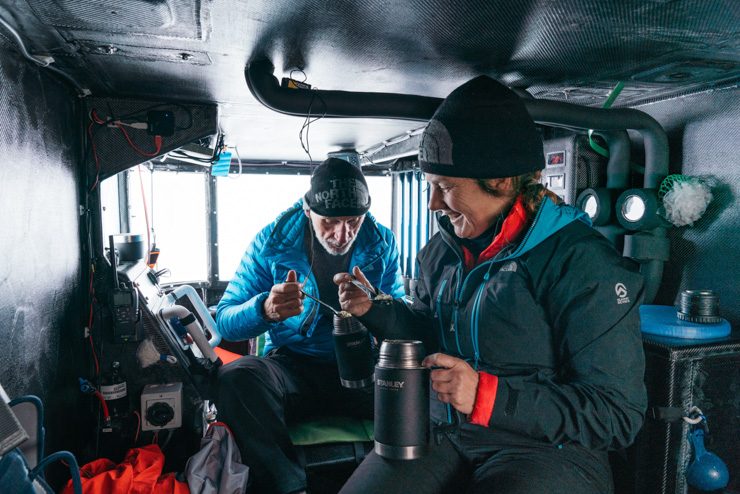
TARGETS
We didn’t reach our target of the geographical South Pole. In our journey in Antarctica, through blizzards, storms, snowfall and amazing sunshine, we learned that what was important was our way of approaching it. It’s about the means and not the end — the journey, not the destination.
It’s human nature to envision a target that you are working towards. And so, we did. We thought about that pole constantly and visualized ourselves standing on it. In many ways that can be a great motivation, but it can also be limiting because often if you don’t reach that target, it can feel as if you’ve failed. If you look at it differently though, you will often see that the target isn’t the end game. In ways it’s only the prompt because you’ve come such a long way and changed so many things in your life. And isn’t that truly the goal?
You get back up and continue. You set new targets for yourself and continue to fight for them.
When you fail to reach a target you take that disappointment, face it, turn it around, and continue. Use it, don’t be used by it. It might be uncomfortable, and it will take some courage, but you can do it. One step at a time. Take small steps and start now. We never know the hidden gift it has in store for us.
Of course, we were disappointed we didn’t reach the pole, but at the same time we felt incredible pride just the same. Every second, we were proudly looking at the vehicle and all its capabilities, of the journey it took from ‘trash’ to ‘truck’ — we were also recognizing what had changed in our own lives and perhaps even in the lives of people we inspired to think differently — all because we started, failed and got back up again.
And really, in this expedition, that felt like the only important target.
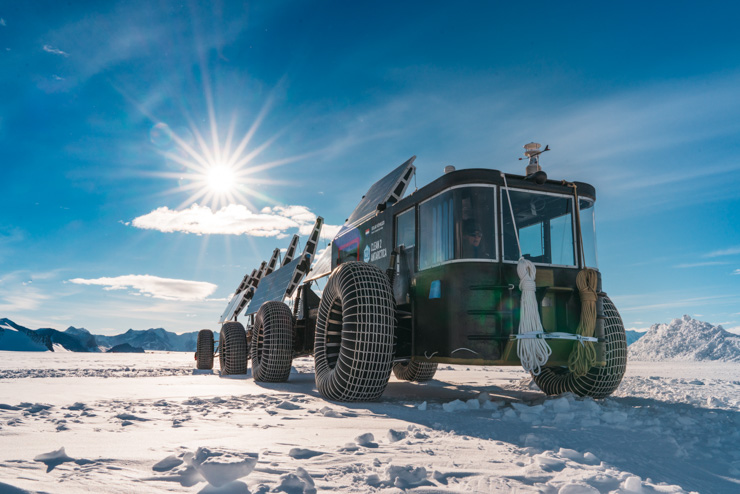
THE RETURN
When we returned home, we all felt a little bit strange. We went from a completely different world, back into the familiar one — yet changed forever. It all felt different from how I knew it. I’m changed, but for some reason, I can’t yet figure out what exactly is different about me. Integration is a process and it’s still unfolding.
We did this for a purpose: a purpose of inspiring others to rethink their own waste. To rethink what it is they produce, and what they can do with that.
To create some turbulence in our own lives, and in society, to get uncomfortable and embrace it.
But mostly, we did it to initiate something — to start small and start now. The beginning is the hardest. With Clean2Antarctica, we proved that it’s possible. Everything is possible, if you just dream it, believe in it and go for it.
We continue on, as there’s lots more to do, and many more people to inspire. We leave Antarctica behind us, but will always take it with us wherever we go. We are a part of each other. This expedition now feels like a crazy, incredibly uncomfortable journey. But there is a shift. In us personally, and also in the people we’ve already inspired, and hopefully in you too just by reading this.
Sometimes you have to get uncomfortable to create a change. And in essence, that is also like an expedition. Embark upon your own expedition towards a more conscious and sustainable life. However you choose to do it, whatever journey you decide to take is up to you. Just go! It’s worth it, I know.
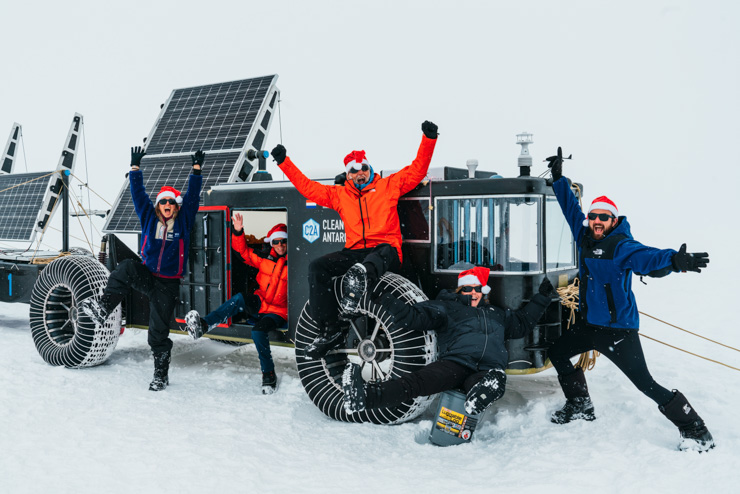
You may also enjoy reading Architecture and Humanity | The Conscious Urbanism of Kunlé Adeyemi by Bill Miles
